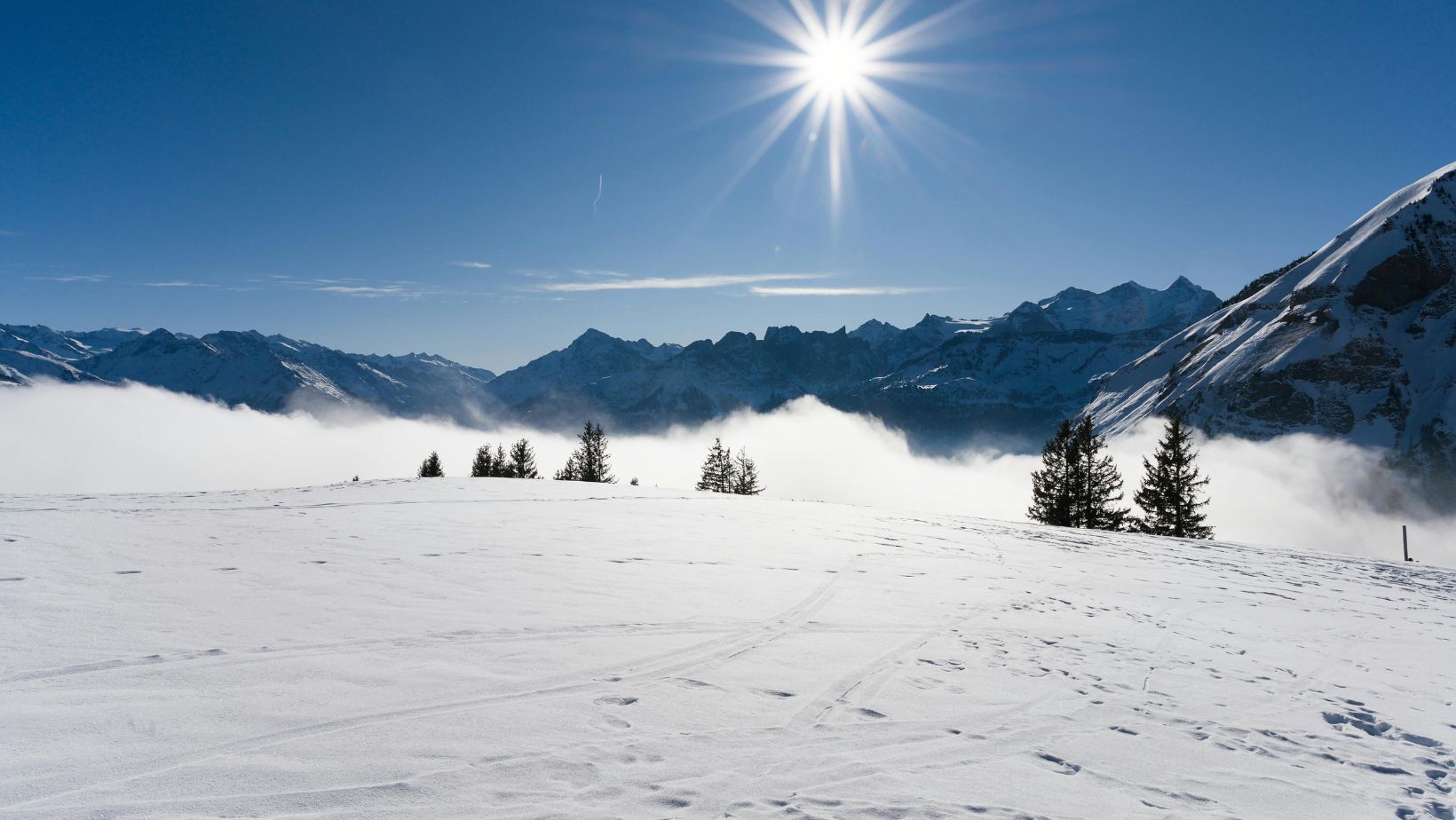To truly experience the Alps like a local, one must acknowledge the steady ebb and flow of life there from season to season. It’s much more than world-renowned ski resorts and treks with views for the ‘Gram. An authentic Alpine experience encompasses food, culture, nature, and community in such a way that locals enjoy what many travelers will never experience – eating seasonal foods, participating in regional events, or trekking less traveled paths – and not because they are better people, but because they have the inside track. Thus, this article aims to not only provide information on how to experience the Alps throughout the year in a more local way but also, expose truths about how travelers can experience the Alps as locals do.
Winter: Experience the Alps’ True Cold-Season Culture
Where tourists perceive winter as merely the prime time for skiing, locals experience the cold-season culture of the Alps as a time for warm rituals and togetherness. Geneva to Megève private transfers make it easy for visitors to slip into this authentic rhythm, arriving comfortably in a village where winter traditions are lived rather than performed. It means joining colleagues at the local café for hot chocolate or glühwein after work and herbal tea made with mountain flowers. It means weekly markets that boast homemade wool products, loaves of fresh bread, and the cheese options that define world-renowned Alpine cuisine. Morning strolls through dusted forests occur long before the lifts open as locals take advantage of quiet early hours in the snow. Slow meals are relished with family over time-tested dishes that came with consistent practice like cheese fondues, stews, and gratins. To experience winter like a local means to embrace comfort and indulge in everything special about the cold and the quiet sweeping across the mountains.
Spring: Experience the Alps’ Transformation from Within
For locals, spring is a time of rejuvenation as the Alps flourish. Spring means time spent in the fields and in the woods to forage for wild herbs and mushrooms before they become too picked over as the crowds come in. Villagers perk up – terraces open to take advantage of the sun hitting the still-cold air after months spent holed up indoors. Low-altitude trails allow for exploration of meadows that bloom long before high-altitude paths become accessible; spring means the terrain tuns colorful before paths up to peak level become accessible. The gardens are prepared; wooden balconies are washed; rituals of land awakening are revived after months of hibernating. To experience spring like a local is to note how much more than inches and feet are changing – the air brings new scents, the slopes welcome new colors, and the absence of snow means chirping birds return to echo across the valleys.
Summer: Experience Life in Full Bloom Like the Locals Do
Summer in the Alps is a time when everything feels alive – and locals embrace every drop of sun they can get. Instead of heading for the busiest trails filled with tourists, locals seek out the more obscure forest paths leading to hidden lakes or non-crowded ridges that boast panoramic views without a wait. Festivals loom over weekends where towns fill with music, traditional garb, and dances honoring centuries-old customs – and everyone’s participation is expected. Locals swim in mountain lakes to cool off, cycle through valleys and up aged roads, or head into a bakery at 6 AM to get fresh pastries before embarking on a day of adventure. Evenings are spent outdoors sharing meals, viewing sunsets from wooden benches, or joining open-air concerts celebrating music’s universal power. To experience summer like a local means to celebrate the warmth and natural growth while simultaneously basking in social engagement brought on by crowds.
Autumn: The Peaceful Season of Tradition and Reflection
For many locals, autumn is the peaceful season of thoughtful reflection and striking tradition. When the mountains turn to gold, and the villages slow to enjoy the process, the people meander through larch forests on casual hikes, taking in the crispness that cuts through the air and the distance. It’s an apple-picking, mushroom-foraging, pumpkin-carving, chestnut-gathering time of year; market stalls overflow from the region’s best offerings and its tastiest foods reach peak flavor. The herds descend from the high pastures, and decorated parades march through towns while music plays, and parties ensue in private chalets, unheard of by outsiders. When in the Alps during autumn as a local, one has more time to appreciate the peacefulness, nature’s rhythm, and authentic calm that arises when crowds aren’t there to disrupt.
Eating Like a Local: Seasonal Cuisine Throughout the Year
One major component of living like a local in the Alps revolves around food. Foods are seasonal; in winter, meals are hearty and warming, relying upon potent flavors from cheeses, potatoes and meats accustomed to long preservation without fresh replacement. In spring, new herbs grow; vegetables are easy to come by, and the delicate cheeses’ flavors come from milk produced before mothers fattened their calves or lambs. In summer, it seems everything is at one’s disposal: berries grow wild, mountain lakes produce trout, and the warmth enables outside cooking and eating. In fall, the earthiness of mushrooms and game coupled with fresh-roasting vegetables and fruits marks a rich time of year before the frost. To eat like a local means to engage in this cycle of foods as seasonal; to understand how food plays a regional role, personality-wise through pervading culture.
Locals Prefer Their Favorite Hidden Places
While there are plenty of places to visit in the Alps to call your trip a success, other places are hidden just beyond the tourist path that are held in high regard by locals. These may include hidden lakes around mountain corners through a brief forest detour; small unknown chalets away from cable cars offering homemade fare; secret lookouts accessible only through hiking rather than cable lifts or paved roads. Many people know of specific traditional boulangeries or mountain huts or thermal baths that aren’t highlighted in guidebooks but remain small nuggets of regional treasure. When one slows down long enough to ask a local for their suggestion – or simply observes where their daily lives take them – they realize there’s more to be had that is personal and special. Exploring hidden gems allow travelers to assess what makes the Alps special for those who live there all year long.
Join Local Festivals and Seasonal Events
Seasons are celebrated in the Alps in ways that help create the rhythms of local life. While many tourists can enjoy Christmas markets, lantern walks and village festivities filled with song and storytelling, spring is a time of new beginnings and it boasts floral festivals and community clean-up efforts to get villages ready for the warmer months ahead. There are summer folk festivals, alpenhorn playing competitions and fairs on the mountains to celebrate crafts unique to the region. Autumn transitions into harvest fests and transhumance celebrations for ancient agricultural practices. By engaging in these local traditions, tourists receive an authentic glimpse into culture, where memories are made on a level rarely achieved through standard tourism efforts.
Understanding the Local Mindset and Mountain Paced Life
To experience the Alps like a local, one must understand the mountain mindset – it’s not merely about existing among beautiful mountains, it’s about being part of something greater. The locals live by the sun, their days dictated by the pace of the mountains, which allow even the coldest of months to keep people outside more than inside. Food changes with the seasons, work endeavors depend upon the weather, and entire villages rely upon connection with each other to keep everything working. Thus, it’s more than just a destination; it’s a way of life. Therefore, for travelers who operate at a hectic pace all year long, the re-adjustment to slower living will take some time, but ultimately, serve as a facilitator for an appreciation not found in most cultures across the world. It’s a mindset focused on what is invaluable over what is tangible.
Experience Alpine Life From the Inside Out
One of the best ways to experience the Alps like a local is by embracing some of their daily rituals to which they hardly pay much attention anymore, they’re so typical. For example, many have a “cheers” with their neighbors in the mornings as they both walk to their village bakery for fresh bread. A quick espresso or herbal tea is stopped by small cafés that get everyone started in good spirits before heading to work or the fields. In the evenings, instead of running around town, everyone enjoys calm days where they can sit on their balconies or on a wooden bench outside as sunset casts warm hues across the tops of the mountains. These moments are shared with locals who often take them for granted but they reveal which values make up Alpine culture; community, simplicity, and a deeper connection with nature. Thus, such quiet moments never make it into any guidebook but surely stick with anyone who embraces this level of authenticity.

Regional Identity and Artisanal Markets
Markets are an essential part of regional identity across the Alps. They’re where travelers find handcrafted creations and seasonal products directly from the source. From bustling village squares in the summer to cozy holiday fairs in the winter, townsfolk sell dairy products, baked goods, woolen clothes, hand-carved toys and tools, and scented pillows or tinctures made from mountain herbs. These markets serve as shopping venues but also as socializing hubs for residents to catch up, tell stories, and keep traditions alive. When travelers frequent these markets, they better understand the Alpine connection to land, culture and sustainability. Furthermore, there are stories behind every stall – families who’ve made the same cheese for decades, shepherds who’ve traversed the same valleys since childhood, artisans who’ve transformed their craft because of local inspiration. These stories add substance to any journey through the Alps.
Small Inns and Mountain Dwellings
There are few better ways to experience life like a local than by spending the night in a family-run inn or authentic mountain dwelling. These accommodations focus on hospitality, homey surroundings and personal touches. Oftentimes travelers are welcomed with homemade recipes passed down through generations, a glass of locally crafted wine and anecdotes about the mountains that are otherwise unheard. Small inns connect travelers to the best accommodations because they offer glimpses into how locals live – how they cook, how they decorate and what they value compared to more complex requirements of life. Rustic mountain huts offer character and personality that large hotels lack; at these places, common spaces for weary day hikers and townsfolk beckon at night for spontaneous meals or conversations that lead to memories that stick, all of which are intimately connected to what it means to truly belong in the mountains.
Experiencing the Seasons Like a Local
Each season for a local is not a separate one-off moment; it’s part of a larger, interconnected story. The stillness of winter, reflective moments and community gatherings transform into the opportunity and expansion that spring invites to reconnect with nature and life. Summer’s active festivals boast daylight late into the night and the days team with things to do. Fall shows transformation and reflection preparing for the winter but also celebrates the harvest. Understanding this movement provides clarity as to why certain traditions exist and why certain foods are prepared when – and why people seem to have such a respectful pause or rhythm throughout the year – all relative to nature. Thus, experiencing the Alps in this way fosters an even greater connection to the region as it’s as much cultural and sophisticated as it is natural and environmental.
Experiencing Year-Round Local Appreciation for Nature/Sustainability
Traveling to the Alps provides honor for experiencing such beautiful landscapes; however, living there creates an entirely new perspective of respect that’s translated into sustainable, natural, everyday practices. Travelers enjoy the beauty from afar, but access limited nature-touched efforts: well-designed trails, wildlife nests, producers who shelter themselves in the summer, in addition to producers who have long kept the traditional values of mountain sourcing. Why are there no one-person, two-person or even larger machines? Because heating takes place with wood in homes, there are balconies with herb gardens, and people buy only what they need from the field or forest. When locals adapt their daily lives in accordance with what’s best for themselves and what’s best for limited resources that a mass amount of people also enjoy, it’s clear that there is more than meets the eye when it comes to experiencing the Alps like a local. They’re not just views; they are homes to many.



